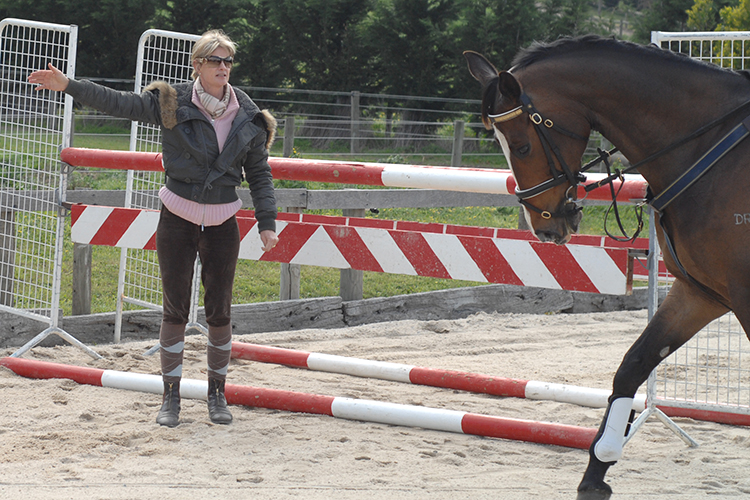 I guess by now you’ve got the picture. Any working session with Michelle starts with SERIOUS flatwork. Not the kind of token couple of laps that you so often see with other jumping trainers, but real gymnastic dressage work aiming to achieve a specific result. Then – and only then – do the jumps go up, but the level of focussed concentration remains much the same.
I guess by now you’ve got the picture. Any working session with Michelle starts with SERIOUS flatwork. Not the kind of token couple of laps that you so often see with other jumping trainers, but real gymnastic dressage work aiming to achieve a specific result. Then – and only then – do the jumps go up, but the level of focussed concentration remains much the same.
Amy has now warmed up Prada to Michelle’s satisfaction, so it is time to set up a few obstacles…
Sure enough, we start with a pole in front of a cross rail, but even over this tiny jump, everything has to be perfect:
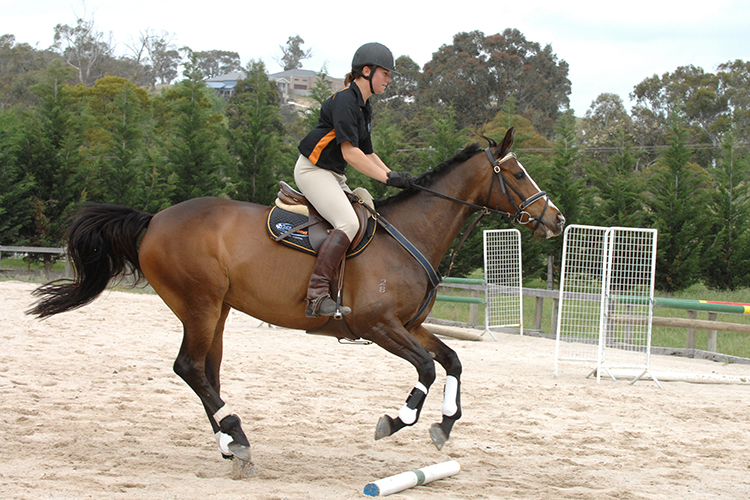
“Make sure your elbows are in front of your body. Keep the neck straight, don’t have her head twisted to the right. If she gets a little mouthy on the approach, you be the still one. You need very steady still hands if she is just a little over-enthusiastic. Don’t get short too quick, keep the nose straight. Very good – straight, straight, straight.”
“Feel your hands are out in front of you, and you actually control the jump – resist the tendency for your body to come forward and your hand to come back. The more balance you have through the air between your hand and leg, the more you can control the shape of the jump. The jump becomes more symmetrical. This is a steady three, so what we would really like is that jump is the same as the canter, the canter is like three speed bumps, then the jump – rather than the big erratic jump, and then she is running to the vertical.”
“For you to be able to control the jump, that means your position through the air has to be steady, and your hand has to be very steady, you can’t over-release, otherwise she’ll just shoot out in front of you. Shorten the reins, now really make sure your elbows are in front of your body, and have her straight.”
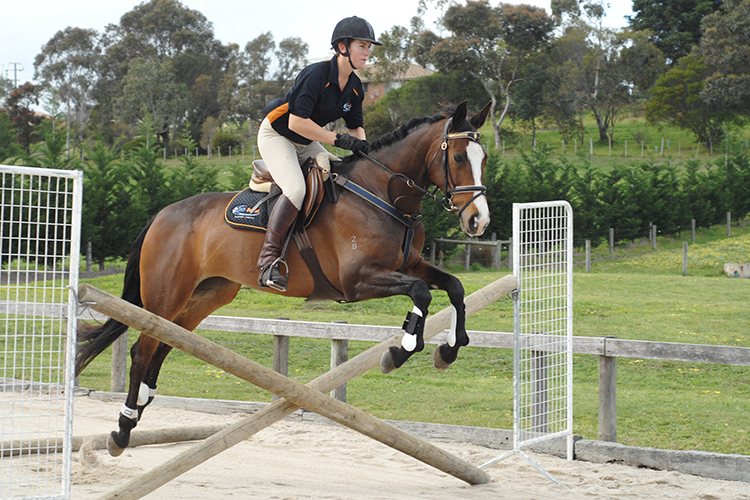
“I want less movement from your body through the air. Don’t have her too short through the turn, because you either end up having to shoot her at it, or over-add. Canter rhythm, rhythm… straight horse, much better, wait now, less body, less body, good.”
Shooting forward and over-adding:
“If you ride the corner before a fence too collected, you take away the natural distance to the fence, so you either keep the horse very short – over-adding because the horse is too short – or increase your leg and push the horse forward out of the very short canter which makes the horse quick off the ground and out of balance, and this makes it harder to keep the jump symmetrical.”
And the issue with straightness that featured in the warmup – it’s the same when the rails are up:
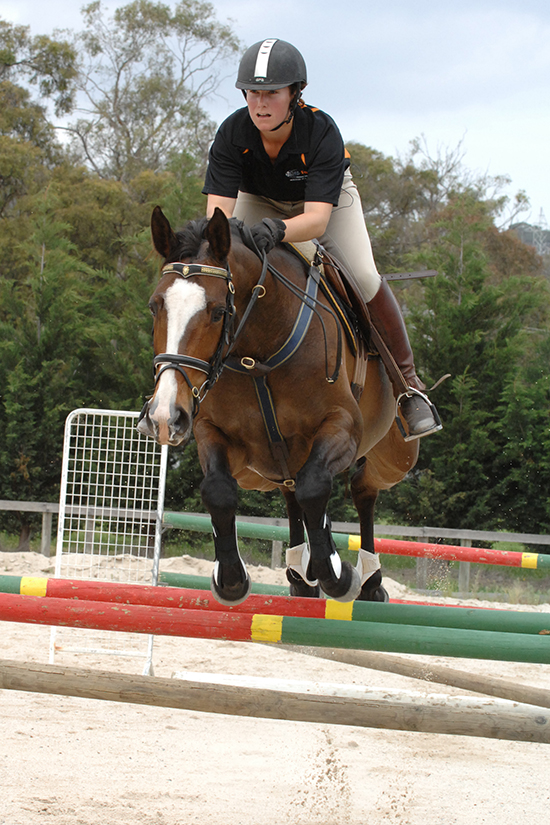
“Straight in the neck, make sure the nose is in the centre of the chest. Make sure her shoulders are directly in front of you, not that the left shoulder is poking out. Encourage that straight jump. Now she’s not straight enough, she’s on two tracks. I don’t want to see her head turning to the right on the approach. Straight, shorten your reins a little. I’d rather you’d have the reins shorter, so I can really see that your elbows stay in front of you in the air. Sit very still through the air.”
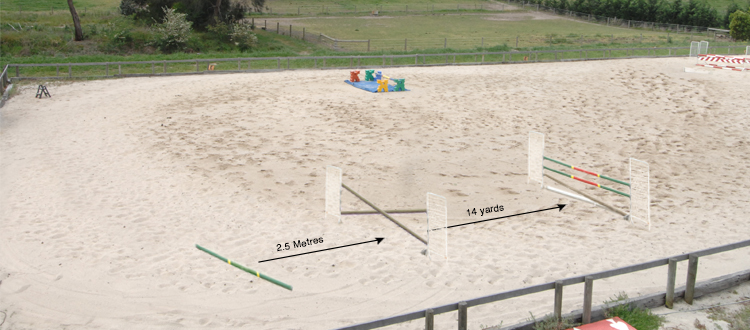
“This exercise really suits this horse, the short (collected) and relaxed three, because it brings her back more on her croup. If I do these exercises with Amy and the grey horse too much, because he’s not so much in front of her leg, they end up being backwards distances, they don’t create the right type of jump.”
“Backwards distances have the same effect as over-adding, the horse becomes short in the neck, and the canter weak, so your eye can’t pick up the more natural distance.”
“We don’t jump courses with Prada some days. We spend a lot of time doing distances where she has to make the mare wait, so she learns to jump off her back end, because she will often just use her big jump instead of using her technique. We try to mix it, so Amy gets to know her better, so they also jump a few courses. If we jump her over some lines today, then tomorrow we might just concentrate on the exercise above, and even have another fence after it, so the mare really has to think about what she is doing with her body.”
“With some horses, little bounces really work well. I find bounces work with this horse, but not too short a bounce because otherwise the mare gets into such a short canter that she gets hoppy behind.”
“It is so much easier with Prada because of all the work she has done on the flat. We have another horse, a four year old, a big one, that Gilbert Böckmann said was a seriously good horse, at the moment we flat it every day, we don’t jump. He’s a nice jumper – by Gordost – but he finds it difficult to canter short, he is just so long that until we get a good canter he is not going to jump. If we do anything else, we are just going to destroy his jump. It’s hard, it’s a difficult canter to connect so it is a big learning curve for Amy – too much hand and he doesn’t canter, not enough hand and he looks like a giraffe.”
“That’s a difficult thing to learn, that balance – that’s when we both ride in a lesson. I ride for a while then Amy gets on, she’ll tell me what she thinks is going on, and I’ll get on to see if I agree with her…”
“Usually I ride it first to get the buck out of it,” quips Amy.
“Absolutely – I’m past that…”
Now Michelle has set up a little course…
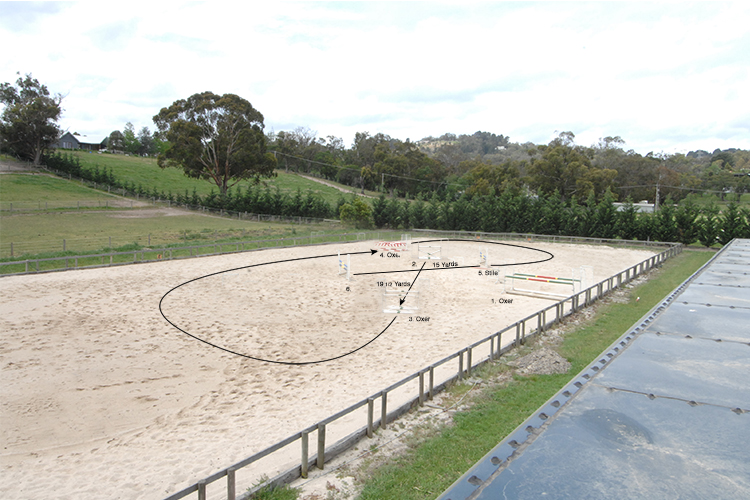
“Okay let’s jump this oxer, come round, jump your line, then up over that oxer, then a steady five, this is just 15 yards, vertical to vertical towards home, that will be steady for her…”
“Steady five???”
“Steady three, sorry.”
“You really want me to sit on my hocks…”
“It will be a really steady three for her, towards home. Lots of body control here. Very very slow body over the stile. OK now it’s up to you… Don’t get too short, too early. Travel through the turn, low hands.”
But Amy isn’t happy…
“As Amy came off the corner to the stile, she initially saw a distance that would have her a little long. Her reaction was to leg Prada and move up to the Stile. Amy then realised that Prada had covered more distance that initially expected, presenting an amended distance that was a little deep. Amy’s reaction to this was to get tight with her hand creating tightness in Prada’s jump over the stile. She just needed to sit still and tall with a soft hand and allow the horse to think and use herself.”
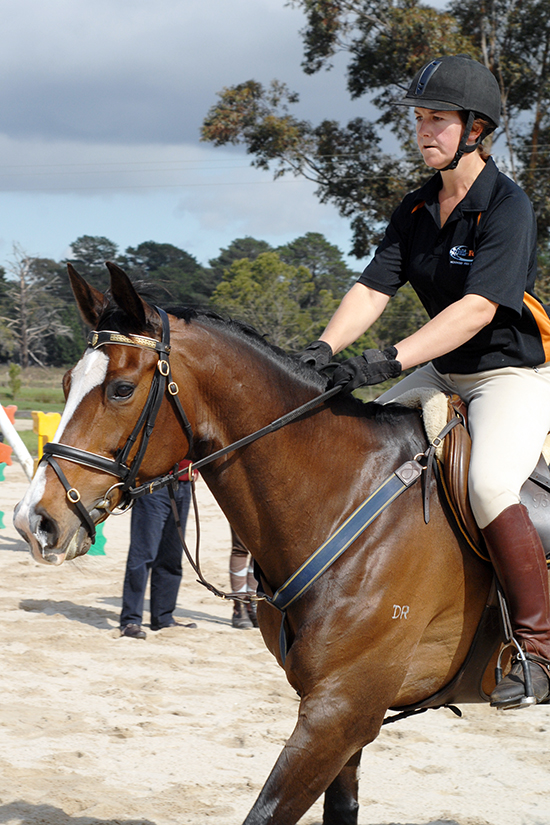
Amy says…
“That’s what I saw!”
“Even though that’s what you saw, you actually over-did it. Try again.”
“Just wait with your body. Low hand, low hand, good very good. Now don’t complicate it, just keep your hands soft and low, and just wait with your eye, wait with your body, and just canter towards it. Beautiful – now body. Wait with your eye, wait with your body, but keep your hands still, beautiful, keep the jump straight, now ride a circle but low hands, don’t try and lift her too much, just try and think of re-balancing the canter, she has to lower her croup – very good – now trot.”
Amy is still not satisfied with her performance…
“What I saw was a bit more forward, if I’d had the canter in the corner I would have got there fine…”
“The actual distance out of the canter was fine, you just overdid it with your leg followed by tightening your hand, you didn’t read her canter very well. Sometimes her canter is bigger than you are used to. You thought she wasn’t going to take you so deep, so you over-rode the canter, and then you ended up getting there deeper than you thought and then having to over correct the deep spot. If she gets to the base, that is not going to do her any harm as long as you are waiting with your eye, waiting with your body, and she has to use more technique, rather than just her big leap.”
Let’s add some more fences…
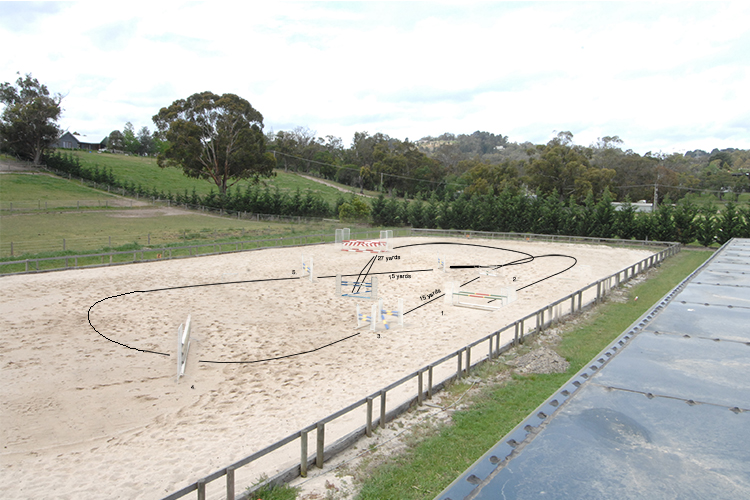
“Alright let’s go down a bending line, 27 yards from the oxer to the Liverpool, in six. If you end up getting a little short to the oxer, and she lands a little steep in there, I don’t want you chasing her down to get the six, do it in seven, because it is a bending line, there is an option to do seven. We know that forward distances are very easy on her…”
“We’ll go one, two, a nice three down there, four to the vertical, back up the steady three to the stile, left, oxer, the six to the Liverpool is the plan. It doesn’t always work to plan but that is the plan. See how I have put the vertical near the wall, so when you come round the turn, that’s a really easy fence to have her turning in the neck but not in the body, especially on the right rein, so make sure she is right in your chute. If she gets a little over-enthusiastic, you just think of the steady low hand.”
“Get your reins short enough to start off with, elbows in front of the body and ride forward now, and then start to assess, don’t get too short too early. Beautiful, low hands, beautifully ridden…”
“Really still body over this vertical. Straight horse, still body, sit up, low hand, body back.”
Amy bends the line to ride the seven between the oxer and the Liverpool…
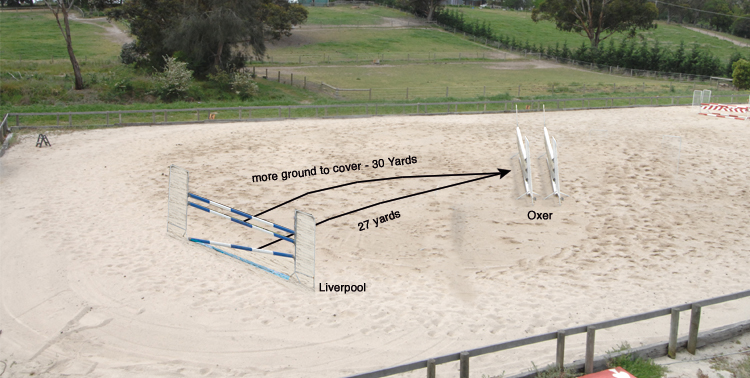
“Good idea, because she jumped a little to the right to the oxer presenting a natural curve in your line. Next time however, I would like to see you ride the direct six stride distance as a bending seven, has encouraged to lean out of her right shoulder, resulting in her not arriving the Liverpool straight and in her chute. Take your time, don’t suffocate her, just think you are trying to bring the balance back otherwise she will just bounce and hop. It’s to feel the balance on her, it’s not a case of just shortening her. Keep cantering until you feel you can bring her balance under herself.”
“Prada over-powers herself, she’s not lazy behind or lacking activity – so you can’t drive her through to a short neck. You’ve got to gradually feel the balance, gradually get the balance back on her hind leg, otherwise she gets frantic because she doesn’t know what to do with all her energy.”
“Because she jumped the oxer to the right, you ended up going wide but that was the right choice to make, to add. The line you rode was like a thirty yard distance so it was a seven.”
“Why don’t we try and do that oxer again. Why don’t you come off the right rein first and just jump this oxer by itself, practise a turn around the stile…”
“Inside the stile?”
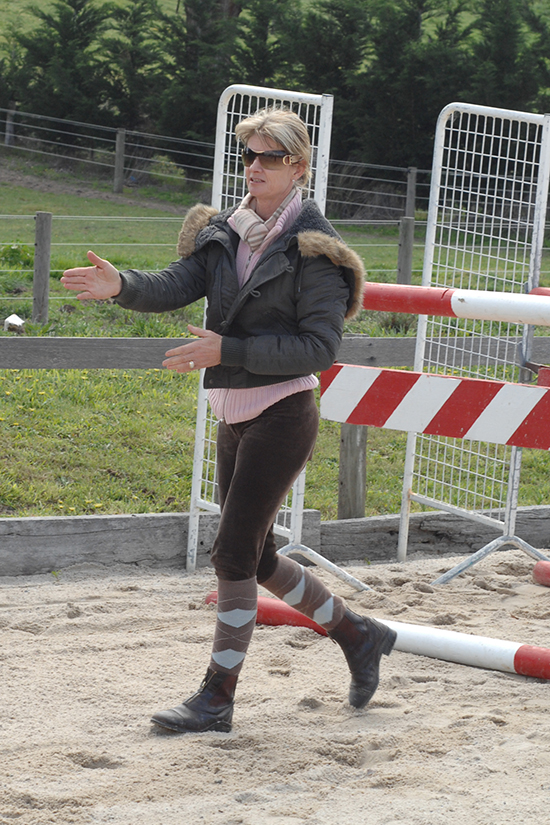
“Killer instinct. Not today Amy, not today, tomorrow… Go round the stile, over the oxer and to the vertical again. We’ll put the stile up a bit. This is what we were talking about before, you’ve got to get very good control with your body and your hands through the air, so you can dictate where you want the front legs to land. If you are in mid air, and you can feel the jump is going slightly to the right, then your position has to be able to control the front legs and shoulders – in a way that still allows your horse to use her neck shoulders through the air. You have to be able to stop the front legs moving across to land to the right. That’s what position is about, that’s what all that jumping without stirrups was for.”
“Bear in mind that she is going to head off to the right naturally, following the line of the fence – they tend to do that indoors too. When you jump, your eyes and your release need to be directing her on the line to the next fence.”
“Have her really straight so she stays in your chute around the turn.”
“Straight, steady body, beautiful. Nicely ridden but you got the seven. Do it again, land and then move. It was beautiful, but we want the six. Land and keep moving, beautiful. It’s good to do both so you have that adjustability.”
Amy can feel where the mare got the message to go in seven: “I probably rode the right line, but when I landed and I sat up and she responded so the seven was more obvious.”
“Exactly, so if you know you have to ride a forward line then you know you land and keep travelling, so that when you get the six in, for the last two strides you feel you can sit up and wait and give the horse time to jump the vertical. I’m glad once you sat up you took the seven, otherwise you would have had to chase her – one minute short, the next minute you are hooning.”
The mare’s education is what makes it possible to fine tune the rider’s body position:
“It just makes my job easier because if you ask with your body, Prada responds, want to do a six, want to do a seven, it’s easy. That’s what Amy is going to start to put into her other horses. That’s the hard thing, if someone has never ridden a horse that’s educated and you take them on, yes, you can help them, but it just makes the work that much harder.”
“Really before a horse starts jumping, it should have those two gears down the line, just over canter poles. That’s what we’ve got to try and teach the big four year old – even though he has got such a beautiful jump there’s no adjustability. Amy can cover that by riding off her eye, rather than riding off the canter, but she has to learn from the canter. She has to be able to read what is going wrong with the canter when she gets those sloppy distances.”
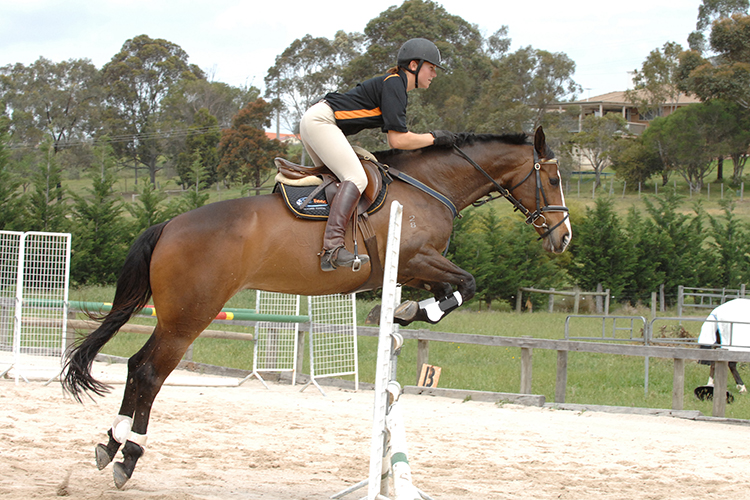
It’s also made easier when the horse is naturally careful:
“This mare was focussed on the fence from the first jump she did. Even if she’s half pigrooting on her approach she never takes her eyes off the rail. You can canter over poles all day long and she’ll just watch them and watch them – she’s always had a natural focus for the top rail.”
It is interesting how differently riders ride on different horses – everything, body shape, control, everything, so different…
“Yes, that’s what I wanted her to feel. She jumped straight on this mare after she had been riding Transatlantic and I said to her, could you feel the difference in you as a rider? In the lesson with Transatlantic she was busy, because she feels like she has to, to create the power on him. I know when I’ve ridden him, there is actually a lot of power in there, and once she starts to tap into it, there’s going to be a whole different level in the horse. Amy has worked a lot on getting Transatlantic softer, now within that softness she’s got to work on creating the power. He was so set in the body that even if you tried to tap him up, you couldn’t. You actually had to get him softer first, and now she can work on the power.”
Time to relax with a loose, swinging trot:
“Okay, give her a walk. Even trotting around like that, you felt that trot – if you get on Transatlantic today and he feels lazy, don’t compromise your rhythm to get forwardness. Put him in front of your leg instead of chasing the rhythm.”
“We were working for the first time on a few short steps yesterday, with another horse, and I was getting Amy to take her leg away but keep the short steps coming under-neath so that she could feel that even with a soft leg the horse can still be active. Rather than feeling like you are squeezing its insides out and pushing it out the front all the time.”
And the difference on the flat comes out in the difference in the jump:
“See the difference when you did the long approach on the oxer with her, to when you did the long approach on Transatlantic to the same fence. On him you were ending up a little away because the canter wasn’t taking you down to the distance. Remember the first few cross rails on Transatlantic yesterday – what did you think of those?”
“I was always getting to get them too open…”
“Because it was very hard to ride the cross rail we wanted to ride, you really want to ride a cross like that on a second option, a waiting distance, (see last month’s Amy and Michelle) but you couldn’t because as soon as your body said ‘wait’, you felt like you were lacking power. I remember when George Morris first came to Australia and he got us to wait to the vertical with no leg, and most trotted. That’s how you’ve got to feel on Transatlantic – and not get trot! – you’ve got to feel you can canter him and sit still like you do on the mare. When you ride her, your body is saying wait – but when you ride Transatlantic, your body is saying, run, run, run.”
That’s enough, time to put Prada away… another training session finished, another building block in the education of a rider.
